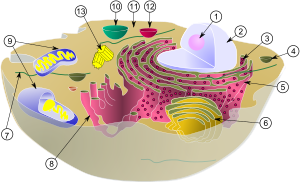
Back Mitochondrium Afrikaans Mitocondria AN ميتوكندريون Arabic Mitoxondri Azerbaijani Мітахондрыя Byelorussian Митохондрия Bulgarian মাইটোকন্ড্রিয়া Bengali/Bangla Mitokondrienn Breton Mitocondri Catalan Siáng-lăk-tā̤ CDO



1 – Jedarce
2 – Jedro
3 – Ribosomi
4 – Vezikula
5 – Hrapavi endoplazmatski retikulum
6 – Golđijev aparat
7 – Mikrotubule
8 – Glatki endoplazmatski retikulum
9 – Mitohondrija
10 – Lizosom
11 – Citoplazma
12 – Mikrosomi
13 – Centriole
Mitohondrija je dvostruko membranski vezana organela koja se nalazi u većini eukariotskih organizma. Mitohondrije stvaraju većinu zaliha ćelijskog adenozin-trifosfata (ATP), koji se kasnije koristi kao izvor hemijske energije, koristeći energiju kisika koji se oslobađa u aerobnom disanju na njenoj unutrašnjoj membrani. Na taj način, mitohondrije imaju ulogu cjeloživotnih ćelijskih energana i jednog od osnovnih tora održavanja homeostaze,[1][2] Prvi ih je otkrio Albert von Kölliker, 1880., u voljnim mišićima insekata. Frazu "ćelijska elektrana" skovao je Philip Siekevitz u istoimenom članku iz 1957.[2]
Nekim ćelijama u nekim višećelijskim organizmima nedostaju mitohondrije (naprimjer, zrela crvena krvna zrnca sisara). Veliki broj jednoćelijskih organizama, kao što su mikrosporidija, parabazalidi i diplomonadi, smanjili su ili transformisali svoje mitohondrije u druge strukture.[3] Poznato je da je jedan eukariot, Monocercomonoides, potpuno izgubio svoje mitohondrije, i jedan višećelijski organizam, Henneguya salminicola, poznato je da su zadržali organele povezane s mitohondrijima u vezi s potpunim gubitkom njihovog mitohondrijskog genoma.[4][5]
Mitohondrije su površine obično između 0,75 i 3 μm2,[6] ali se značajno razlikuju po veličini i strukturi. Osim ako nisu posebno obojene, nisu vidljive. Osim snabdijevanja ćelijskom energijom, mitohondrije su uključene u druge funkcije, kao što su signalizacija, ćelijska diferencijacija i ćelijska smrt, kao i održavanje kontrole [ [ćelijski ciklus|ćelijskog ciklusa]] i ćelijskog rasta.[2]
Mitohondrijska biogeneza je zauzvrat vremenski usklađena sa ovim ćelijskim procesima.[7][8] Mitohondrije su uključene u nekoliko ljudskih poremećaja i stanja, kao što su mitohondrijske bolesti,[9] srčana disfunkcija,[10] otkazivanje srca [11] i autizam.[12]
- ^ Campbell NA, Williamson B, Heyden RJ (2006). Biology: Exploring Life. Boston, Massachusetts: Pearson plc/Prentice Hall. ISBN 978-0-13-250882-7.
- ^ a b c Schmidt-Rohr K (2020). "Oxygen Is the High-Energy Molecule Powering Complex Multicellular Life: Fundamental Corrections to Traditional Bioenergetics". ACS Omega. 5 (5): 2221–2233. doi:10.1021/acsomega.9b03352. PMC 7016920. PMID 32064383.
- ^ Henze K, Martin W (novembar 2003). "Evolutionary biology: essence of mitochondria". Nature. 426 (6963): 127–128. Bibcode:2003Natur.426..127H. doi:10.1038/426127a. PMID 14614484. S2CID 862398.
- ^ "Animal that doesn't need oxygen to survive discovered New Scientist". www.newscientist.com. Pristupljeno 25. 2. 2020.
- ^ Yahalom, Dayana; Atkinson, Stephen D.; Neuhof, Moran; Chang, E. Sally; Philippe, Hervé; Cartwright, Paulyn; Bartholomew, Jerri L.; Huchon, Dorothée (19. 2. 2020). "A cnidarian parasite of salmon (Myxozoa: Henneguya) lacks a mitochondrial genome". Proceedings of the National Academy of Sciences (jezik: engleski). 117 (10): 5358–5363. doi:10.1073/pnas.1909907117. ISSN 0027-8424. PMC 7071853. PMID 32094163.
- ^ Wiemerslage L, Lee D (mart 2016). "Quantification of mitochondrial morphology in neurites of dopaminergic neurons using multiple parameters". Journal of Neuroscience Methods. 262: 56–65. doi:10.1016/j.jneumeth.2016.01.008. PMC 4775301. PMID 26777473.
- ^ Valero T (2014). "Mitochondrial biogenesis: pharmacological approaches". Current Pharmaceutical Design. 20 (35): 5507–9. doi:10.2174/138161282035140911142118. hdl:10454/13341. PMID 24606795.
Mitochondrial biogenesis is therefore defined as the process via which cells increase their individual mitochondrial mass [3]. ... Mitochondrial biogenesis occurs by growth and division of pre-existing organelles and is temporally coordinated with cell cycle events [1].
- ^ Sanchis-Gomar F, García-Giménez JL, Gómez-Cabrera MC, Pallardó FV (2014). "Mitochondrial biogenesis in health and disease. Molecular and therapeutic approaches". Current Pharmaceutical Design. 20 (35): 5619–33. doi:10.2174/1381612820666140306095106. PMID 24606801.
Mitochondrial biogenesis (MB) is the essential mechanism by which cells control the number of mitochondria
- ^ Gardner A, Boles RG (2005). "Is a 'Mitochondrial Psychiatry' in the Future? A Review". Curr. Psychiatry Rev. 1 (3): 255–271. doi:10.2174/157340005774575064.
- ^ Lesnefsky EJ, Moghaddas S, Tandler B, Kerner J, Hoppel CL (juni 2001). "Mitochondrial dysfunction in cardiac disease: ischemia--reperfusion, aging, and heart failure". Journal of Molecular and Cellular Cardiology. 33 (6): 1065–89. doi:10.1006/jmcc.2001.1378. PMID 11444914.
- ^ Dorn GW, Vega RB, Kelly DP (oktobar 2015). "Mitochondrial biogenesis and dynamics in the developing and diseased heart". Genes & Development. 29 (19): 1981–91. doi:10.1101/gad.269894.115. PMC 4604339. PMID 26443844.
- ^ Griffiths KK, Levy RJ (2017). "Evidence of Mitochondrial Dysfunction in Autism: Biochemical Links, Genetic-Based Associations, and Non-Energy-Related Mechanisms". Oxidative Medicine and Cellular Longevity. 2017: 4314025. doi:10.1155/2017/4314025. PMC 5467355. PMID 28630658.